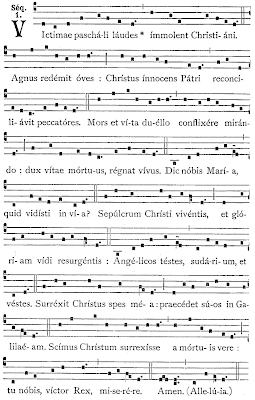 At the Paschal celebration on Easter day, we sing, in addition to other hymns about the Resurrection, one of the several Sequence hymns appointed for the Liturgy on special feast days. Both the text and melody of this hymn, “Christians, to the Paschal Victim” (Victimae paschali laudes, #105 in the St. Ambrose Hymnal) were written in the early 11th century by Wipo of Bergundy, who died in 1030.
At the Paschal celebration on Easter day, we sing, in addition to other hymns about the Resurrection, one of the several Sequence hymns appointed for the Liturgy on special feast days. Both the text and melody of this hymn, “Christians, to the Paschal Victim” (Victimae paschali laudes, #105 in the St. Ambrose Hymnal) were written in the early 11th century by Wipo of Bergundy, who died in 1030.
Sequence hymns were part of a gradual development that, in “domino” fashion, saw the evolution of several different artistic forms through the centuries.
The theory of music historians is that it all began with the Alleluia, chanted before the Gospel (except during Lent). Somewhere, at some time, chanters began to elaborate on the last syllable of the last alleluia until that “a” had become a long melismatic phrase. Although they were simply improvised at first, it became desirable to preserve some of the melodies for future use (and perhaps to restrain extravagant performances by individual singers!) The music of the Church at this time was learned from memory and passed to others orally so, in order to remember the improvised melodies, it became necessary to fill in those long phrases with more words. Eventually these became distinct compositions in themselves and were separated from the Alleluia to form the Sequence hymn.
Later, the melody of Victimae paschali laudes was modified by Germanic composers, vernacular words were then added to the Latin ones, and this became the pre-Reformation chorale “Christ ist erstanden” (the melody of hymn 104 in the SAH). Martin Luther used the melody as the basis for his chorale “Christ Lag in Todesbanden.”
Because Wipo’s text is written in dialogue form, the hymn lent itself easily to dramatic presentation. It is believed that this, along with the chanting of the Passion Gospels in dialogue form, provided the inspiration for Medieval Mystery and Miracle plays, which eventually opened the door for the composition of Oratorios. So, from the tiny “mustard seed” of a chanter’s ecstatic rendition of the Alleluia grew a mighty tree with many branches!
By the 15th century, Sequence hymns had become so numerous (and the quality of both texts and melodies so varied) that the Council of Trent barred the use of all but five of the hymns in Roman Catholic churches. Four of these are specified in the Orthodox Missal for use in Western Rite liturgies: Veni Sancte Spiritus for Pentecost, Lauda Sion for Corpus Christi, and Dies Irae for Requiem masses, in addition to the Easter Sequence. The St. Ambrose Hymnal also includes a number of other Sequences: “Thou For Ever our Salvation” (#41) for Advent; “The Strain Upraise of Joy and Praise” (#74) for the Last Sunday of Epiphany; “Blessed Feasts of Blessed Martyrs” (#252) for feasts of the martyrs; “Joy and Triumph Everlasting” (#231) for All Saints; “Come, Pure Hearts, in Sweetest Measure” and “Choirs, Rejoice, Those Heralds Praising” (#247 and 248) for feasts of Evangelists.
As we raise our voices in singing these beautiful hymns, let us remember that joyful chanter of so long ago and be thankful.